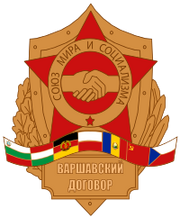No edit summary |
(Adding categories) |
||
| Line 67: | Line 67: | ||
[[Category:USSR]] |
[[Category:USSR]] |
||
[[Category:Soviet Military]] |
[[Category:Soviet Military]] |
||
| + | [[Category:Soviet Bloc States/Nations]] |
||
Revision as of 14:39, 24 January 2014
The treaty friendship, Co-operation and mutual assistance more commonly referred to as the Warsaw Pact, was a mutual defense treaty between 8 communist states in eastern and central europe in existence during the Cold War. The fouding treaty was established under the initiative of the soviet union and signed on 14 May 1955, in Warsaw. The Warsaw Pact was the military complement to the Council for Mutual Economic Assistance (Comecon), the regional economic organization for the communist states of east and central europe. The warsaw pact was in part a soviet military reaction to the intergration of West Germany into NATO in 1955 per the Paris pacts of 1954 but was primarily motivated by soviet desires to maintain control over military forces in Central and Eastern Europe which in turn (according to the Warsaw pact's preamble) to maintain peace in Europe, guided by the objective points and principles of the charter of the United Nations (1945)..
Structure
The Warsaw Treaty's organization was two-fold: The Political Counsultative Committee handled political matters, and the Combined command of pact armed forces controlled assigned multi-national forces, with headquarthers in Warsaw, Poland. Furthermore, the supreme commander of the Unified Armed Forces of the Warsaw Treaty organization was also a first deputy minister of defense of the USSR, and the head of the Warsaw Treaty combined staff also was a first deputy Chief of also was a first deputy chief of the Armed Forces of the USSR. Therefore, although ostensibly an international collective security alliance, the USSR dominated the Warsaw Treaty armed forces.

